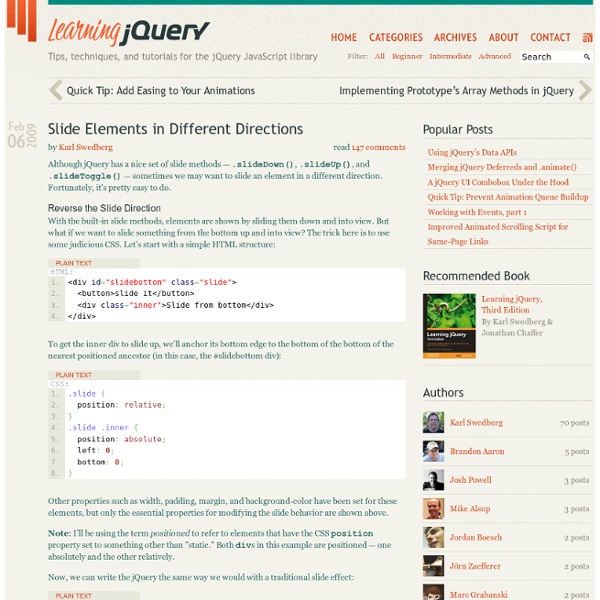Slide Elements in Different Directions

12 Wesbite to Learn jQuery
Jquery is a great way to get a lot of cool things to happen on your website. You must take the time to learn it, in this post I give you 12 Wesbites to Learn jQuery. This is just to get your feet wet its always best to take a class or pick up a book. jquery-mix.com jqueryfordesigners.com 15daysofjquery.com jqueryking.com addyosmani.com docs.jquery.com tutorialzine.com visualjquery.com jquerystock.com developphp.com jquerystyle.com marcgrabanski.com
Custom Selectors - jQuery
Select all elements that are in the progress of an animation at the time the selector is run. Selects elements that have the specified attribute with a value either equal to a given string or starting with that string followed by a hyphen (-). Selects elements that have the specified attribute with a value containing the a given substring. Selects elements that have the specified attribute with a value containing a given word, delimited by spaces. Selects elements that have the specified attribute with a value ending exactly with a given string. Selects elements that have the specified attribute with a value exactly equal to a certain value. Select elements that either don’t have the specified attribute, or do have the specified attribute but not with a certain value. Selects elements that have the specified attribute with a value beginning exactly with a given string. Selects all button elements and elements of type button. Selects all elements of type checkbox.
CSS selectors jQuery
Select all elements that are in the progress of an animation at the time the selector is run. Selects elements that have the specified attribute with a value either equal to a given string or starting with that string followed by a hyphen (-). Selects elements that have the specified attribute with a value containing the a given substring. Selects elements that have the specified attribute with a value containing a given word, delimited by spaces. Selects elements that have the specified attribute with a value ending exactly with a given string. Selects elements that have the specified attribute with a value exactly equal to a certain value. Select elements that either don’t have the specified attribute, or do have the specified attribute but not with a certain value. Selects elements that have the specified attribute with a value beginning exactly with a given string. Selects all button elements and elements of type button. Selects all elements of type checkbox.
3 Simple Things to Make Your jQuery Code Awesome
jQuery is one of the most popular (if not the most) JavaScript libraries in existence and a great number of people use it to do some amazing things. Personally, jQuery is what got me excited for learning JavaScript. The problem is that a lot of programmers don't understand that with all that power massive amounts of CPU cycles are used. As much as jQuery engineers try to optimize jQuery, they are always limited in how fast they can make it go. There are a few things that you, as a user of jQuery, can do to make your jQuery code faster. 1 - jQuery Object Caching Caching your jQuery objects may possibly be the best thing you can do to cut your code down to run leaner and meaner. In all of these cases, you could save some DOM searching trips by assigning the jQuery object to a variable (generally prefixed with a dollar sign to distinguish it as a jQuery object), like so: 2 – Selector Optimization The following selectors are ranked from fastest to slowest. 3 – Delegating Events About the Author
Related:
Related:



